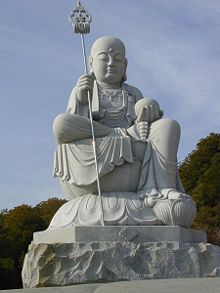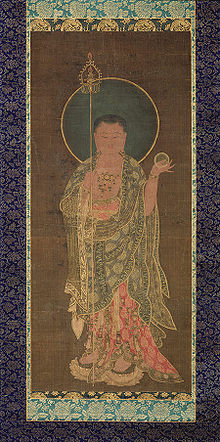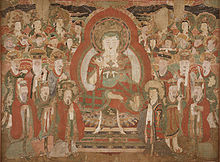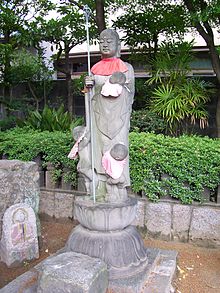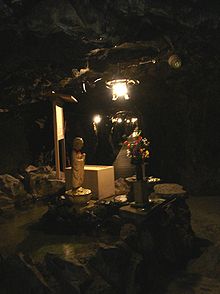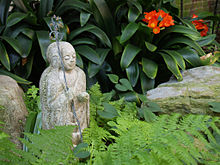- Ksitigarbha
-
Ksitigarbha 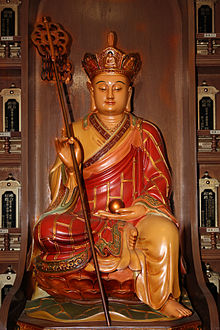
Traditional Chinese depiction of Ksitigarbha as a monk holding a staff and a cintamani pearl.Sanskrit: Kṣitigarbha Chinese: TC: 地藏, 地藏菩薩, 地藏王菩薩
SC: 地藏, 地藏菩萨, 地藏王菩萨
Pinyin: Dìzàng, Dìzàng Púsà, Dìzàng Wáng Púsà
Wade-Giles: Ti Tsang, Ti Tsang Pu Sa, Ti Tsang Wang Pu SaJapanese: 地蔵 Jizō, 地蔵菩薩 Jizō Bosatsu, 地蔵王菩薩 Jizōō Bosatsu, Ojizō-sama พระกษิติครรภ์โพธิสัตว์ Phra Ksitikhan Phothisatt Tibetan: Sai Nyingpo Mongolian: Сайенинбу Korean: 지장, 지장보살, ji jang, ji jang bosal Vietnamese: Địa Tạng Vương Information Venerated by: Mahayana, Vajrayana Attributes: Great vows Ksitigarbha (Sanskrit: क्षितिगर्भ Kṣitigarbha) is a bodhisattva primarily revered in East Asian Buddhism, usually depicted as a Buddhist monk in the Orient. The name may be translated as "Earth Treasury", "Earth Store", "Earth Matrix", or "Earth Womb". Ksitigarbha is known for his vow to take responsibility for the instruction of all beings in the six worlds between the death of Gautama (Sakyamuni) Buddha and the rise of Maitreya Buddha, as well as his vow not to achieve Buddhahood until all hells are emptied. He is therefore often regarded as the bodhisattva of hell beings, as well as the guardian of children and patron deity of deceased children and aborted fetuses in Japanese culture. Usually depicted as a monk with a nimbus around his shaved head, he carries a staff to force open the gates of hell and a wish-fulfilling jewel to light up the darkness.
Contents
Overview
Ksitigarbha is one of the four principal bodhisattvas in East Asian Mahayana Buddhism. The others are Samantabhadra, Manjusri, and Avalokitesvara.
At the pre-Tang Dynasty grottos in Dunhuang and Longmen, he is depicted in classical bodhisattva shape. After the Tang Dynasty, he became increasingly depicted as a monk, carrying rosaries and a staff.
His full name in Chinese script is (simplified Chinese: 大願地藏菩萨; traditional Chinese: 大願地藏菩薩; pinyin: Dàyuàn Dìzàng Púsà), or the Bodhisattva King Dizang of the Great Vow, pronounced as Dayuan Dizang Pusa in Mandarin Chinese, Daigan Jizō Bosatsu in Japanese, and Jijang Bosal in Korean.
This is a reference to his pledge, as recorded in the sutras, to take responsibility for the instruction of all beings in the six worlds, in the era between the death of Gautama Buddha and the rise of Maitreya Buddha. Because of this important role, shrines to Ksitigarbha often occupy a central role in any Oriental Mahayana temple, especially within the memorial halls or mausoleums.
Source
As a Brahmin Maiden
The story of Ksitigarbha is first described in the Sutra of The Great Vows of Ksitigarbha Bodhisattva, one of the most popular Mahayana Buddhist sutras. This sutra is said to have been spoken by the Buddha towards the end of his life to the beings of the Trayastrimsa Heaven as a mark of gratitude and remembrance for his beloved mother, Māyādevī.[1] But most scholars believe the sutra was compiled in China.[2] It stated that Ksitigarbha practiced filial piety as a mortal, which eventually led to making great vows to save all sentient beings. In the Ksitigarbha Sutra, the Buddha states that in the distant past eons, Ksitigarbha was a Brahmin maiden by the name of Sacred Girl. She was deeply troubled when her mother died, because she had often been slanderous towards the Triple Gem. To save her from the great tortures of hell, the girl sold whatever she had and used the money to buy offerings that she offered daily to the Buddha of her time, known as The Buddha of Flower of Meditation and Enlightenment. She prayed fervently that her mother be spared the pains of hell and appealed to the Buddha for help.[3]
While she was pleading for help at the temple, she heard Buddha telling her to go home, sit down, and recite his name if she wanted to know where her mother was. She did as she was told and her consciousness was transported to a Hell Realm where she met a guardian who informed her that through her fervent prayers and pious offerings, her mother had accumulated much merit and had already ascended to heaven. Sacred Girl was greatly relieved and would have been extremely happy, but the sight of the suffering she had seen in Hell touched her heart. She vowed to do her best to relieve beings of their suffering in her future lives of kalpas.[4]
As a Buddhist monk
There is a legend about how Ksitigarbha manifested himself in China, and chose his bodhimanda to be Mount Jiuhua, one of the Four Sacred Mountains of China in Buddhism.
In the Eastern Han dynasty, during the reign of Emperor Ming, Buddhism started to flourish, reaching its peak in the era of the Tang Dynasty, eventually spreading to Korea. At the time, monks and scholars arrived from those countries to seek the Dharma in China. One of these pilgrims was a former prince from Silla whose Korean romanization was Kim Kiaokak (Ch: Jin Qiaojue(金喬覺)) and became a monastic under the name of Earth Store (Also called Jijang, the Korean pronunciation of Dizang).[5] He came to the region of Anhui to Mount Jiuhua. After ascending, he decided to build a hut in a deep mountain area so that he may be able to cultivate.
According to records, the monk was bitten by a poisonous snake, but did not move, thus letting the snake go. A woman happened to pass by and gave the monk medicines to cure him of the venom, as well as a spring on her son's behalf. For a few years, the monk continued to meditate in his hut, until one day, a scholar named Chu-Ke led a group of friends and family to visit the mountain. Noticing the monk meditating in the hut, they went and took a look at his condition. They had noticed that the monk's bowl did not contain any food, and that his hair had grown back.
Feeling pity on the monk, Scholar Chu decided to build a temple as an offering to the monk. The whole group descended the mountain immediately to discuss plans to build the temple. Mount Jiuhua was also property of a wealthy person named the elder Wen-Ke, who obliged to build a temple on his mountain. Therefore, Wen-Ke and the group ascended the mountain once more and asked the monk how much land he needed.
The monk replied that he needed a piece of land that could be covered fully by his kasaya. Bewildered that a piece of sash could not be enough land to build a temple, the monk surprised them as he threw the kasaya in the air, and the robe expanded in size, covering the entire mountain! Elder Wen-Ke had then decided to renounce the entire mountain to the monk, and became the monk's protector. Sometime later, Wen-Ke's son also left the home life to start his life as a monk.
The monk lived in Mount Jiuhua for seventy five years before passing away at the age of ninety-nine. Three years after his nirvana, his tomb was opened, only to reveal that the body had not decayed. Because the monk led his wayplace with much difficulty, most people had the intuition to believe that he was indeed the transformation body of Ksitigarbha.
Monk Jijang's well-preserved, dehydrated body may still be viewed today at the monastery he built on Mount Jiuhua.
Iconography
Traditional iconography
In Buddhist iconography, Ksitigarbha is typically depicted with a shaven head, dressed in a monk's simple robes (unlike most other bodhisattvas, who are dressed like Indian royalty). In his left hand, Ksitigarbha holds a wish granting jewel; in his right hand, he holds a monk's staff called in Japanese a shakujo (錫杖) (jingle staff), which is used to alert insects and small animals of his approach, so that he will not accidentally harm them. Such a staff is traditionally carried by monks. In the Chinese tradition, Ksitigarbha sometimes is seen wearing a crown depicting the Five Dhyani Buddhas, worn by Tibetan and Chinese monks in Tantric rituals.
Like other Bodhisattvas, Ksitigarbha usually is seen standing upon a lotus base, symbolizing his release from the karmic wheel of rebirth. Ksitigarbha's face and head are also idealized, featuring the third eye, elongated ears and the other standard attributes of an enlightened being.
Iconography in Japan
The Narihira Santosen Temple in Katsushika, Tokyo contains the "Bound Jizō" of Ōoka Tadasuke fame, dating from the Edo Period. When petitions are requested before the Jizō, the petitioner ties a rope about the statue. When the wish is granted, the petitioner unties the rope. At the new year, the ropes of the ungranted wishes are cut by the temple priest. The vandalism of a Jizō statue is the theme of the J-Horror movie Shibuya Kaidan. The anime series Hell Girl is also loosely based on the legend of the Jizō and the zanpakuto of Mayuri Kurotsuchi from Bleach is Konjiki Ashisogi Jizo (Golden Leg-cutting Jizō). Also the dark mass spell utilised by Jellal Fernandes in Fairy tail features the outline of Ksitigarbha's face when launched.
In Buddhist traditions
In China
Jiuhua Mountain in Anhui is regarded as Ksitigarbha's seat. It is one of the four great Buddhist mountains of China, and at one time housed more than 300 temples. Today, 95 of these are open to the public. The mountain is a popular destination for pilgrims offering dedications to Ksitigarbha.
In some areas, the admixture of traditional religions has led to Ksitigarbha being also regarded as a Taoist deity, albeit his duties differ to what Ksitigarbha does. For example, in Hong Kong and among Overseas Chinese communities, his images are usually found in the memorial halls of Buddhist and Taoist temples.
In Japan
In Japan, Ksitigarbha, known as Jizō, or Ojizō-sama as he is respectfully known, is one of the most loved of all Japanese divinities. His statues are a common sight, especially by roadsides and in graveyards. Traditionally, he is seen as the guardian of children, particularly children who died before their parents. Since the 1980s, he has been worshiped as the guardian of the souls of mizuko, the souls of stillborn, miscarried or aborted fetuses, in the ritual of mizuko kuyō (水子供養, lit. offering to water children). In Japanese mythology, it is said that the souls of children who die before their parents are unable to cross the mythical Sanzu River on their way to the afterlife because they have not had the chance to accumulate enough good deeds and because they have made the parents suffer. It is believed that Jizō saves these souls from having to pile stones eternally on the bank of the river as penance, by hiding them from demons in his robe, and letting them hear mantras.[citation needed]
Jizō statues are sometimes accompanied by a little pile of stones and pebbles, put there by people in the hope that it would shorten the time children have to suffer in the underworld. (The act is derived from the tradition of building stupas as an act of merit-making.) The statues can sometimes be seen wearing tiny children's clothing or bibs, or with toys, put there by grieving parents to help their lost ones and hoping that Jizō would specially protect them. Sometimes the offerings are put there by parents to thank Jizō for saving their children from a serious illness. Jizō's features are commonly made more babylike to resemble the children he protects.
As he is seen as the saviour of souls who have to suffer in the underworld, his statues are common in cemeteries. He is also believed to be one of the protective deities of travelers, the dōsojin, and roadside statues of Jizō are a common sight in Japan. Firefighters are also believed to be under the protection of Jizō.
In Southeast Asia
In Theravada Buddhism, the story of a Buddhist monk called Phra Malai, who has the similar qualities of Ksitigarbha, is well known throughout Southeast Asia, especially in Thailand and Laos. Legend has it that he was an arhat from Sri Lanka, who achieved great supernormal powers through his own merits and meditation. He is also honored as a successor to Maudgalyayana, the Buddha's disciple foremost for his supernormal attainments. In the story this pious and compassionate monk descends to Hell to give teachings & comfort the suffering hell-beings there. He also learns how the hell-beings are punished according to their sins in the different hells.
Mantras
In Shingon and other schools of East Asian Esoteric Buddhism, the mantra of Ksitigarbha comes from the "Treasury of Mantras" section of the Mahāvairocana Sūtra. The effect of this mantra is producing the "Samadhi Realm of Adamantine Indestructible Conduct." This mantra is the following:[6]
In Chinese Buddhism, the following mantra is associated with Ksitigarbha:
námó dìzàng wáng púsà (南無地藏王菩萨)In Korean Buddhism, the following mantra is associated with Ksitigarbha:
namo jijang bosalIn Tibet, the following mantra is associated with Ksitigarbha:
oṃ kṣitigarbha bodhisattva yaḥIn Shingon, a mantra used in public religious services is:[8]
on kaka kabi sanmaei sowakaHaikus
falling freely
tears and rain
on the garden JizoNamekuji-ni
kuchi-o suwareta
ishi-jizoThe stone image of Jizo
kissed on the mouth
by a slug
(from Senryū)Suzume no ko
Jizoo no sode ni
kakurekeriThe young sparrows
return into Jizo's sleeve
for sanctuary
(from Issa)Nadeshiko ya
jizô bosatsu no
ato saki niBlooming pinks
behind and in front
of Saint Jizo
(from Issa)Aki-no kure
tsuji-no Jizo-ni
abura sasuIn autumn dusk
at the wayside shrine for the Jizo image
I pour more votive oil
(from Buson)In works of Lafcadio Hearn
The Legend of the Humming of the Sai-no-Kawara, by Lafcadio Hearn:
- But lo! the teacher Jizô appears,
- All gently he comes, and says to the weeping infants:
- "Be not afraid, dears! be never fearful!
- Poor little souls, your lives were brief indeed!
- Too soon you were forced to make the weary journey to the Meido,
- The long journey to the region of the dead!
- Trust to me! I am your father and mother in the Meido,
- Father of all children in the region of the dead."
- And he folds the skirt of his shining robe about them;
- So graciously takes he pity on the infants.
- To those who cannot walk he stretches forth his strong shakujô,
- And he pets the little ones, caresses them, takes them to his loving bosom.
- So graciously he takes pity on the infants.
- Namo Jizo Bosatsu!
See also
- Mizuko kuyō
- Butsu Zone, a manga in which Jizo is a main character
- Mount Jiuhua, is one of the four sacred mountains of Chinese Buddhism dedicated to Ksitigarbha.
References
- ^ Ksitigarbha Sutra - Chapter One: Miracles In The Palace Of The Trayastrimsas Heaven: - "Thus have I heard. Once the Buddha was abiding in Trayastrimsas Heaven in order to expound the Dharma to his mother."
- ^ Jizo Bodhisattva: Guardian of Children, Travelers, and Other Voyagers at Google Books page 193
- ^ http://www.buddhanet.net/e-learning/history/tstang-txt.htm Ti Tsang P'usa: Ksitigarbha Bodhisattva
- ^ http://www.buddhanet.net/e-learning/history/tstang-txt.htm Ti Tsang P'usa: Ksitigarbha Bodhisattva
- ^ 释地藏金乔觉考
- ^ Giebel, Rolf. The Vairocanābhisaṃbodhi Sutra. Berkeley: Numata Center, 2005
- ^ Giebel, Rolf. The Vairocanābhisaṃbodhi Sutra. Berkeley: Numata Center, 2005
- ^ Shingon Buddhism and Jizo
Bibliography
- Jizo Bodhisattva: modern healing & traditional Buddhist practice, by Jan Chozen Bays at Google Books
- Jizo Bodhisattva: Guardian of Children, Travelers, and Other Voyagers, by Jan Chozen Bays at Google Books
- The Making of a Savior Bodhisattva: Dizang in Medieval China, by Zhiru at Google Books
External links
- Jizo Bodhisattva - Photo Dictionary of Japanese Buddhism
- Jizo Bodhisattva: modern healing and traditional Buddhist practice (ISBN 0-8048-3189-0)
- Dizang text from Dunhuang
- The Earth Store (Treasury) Sutra is a text on Ksitigarbha Bodhisattva
- The Earth Store Sutra with commentary
Bodhisattvas General list Avalokitesvara (Guan Yin) · Manjushri · Samantabhadra · Ksitigarbha · Maitreya · Mahasthamaprapta · AkasagarbhaChinese Vajrayana Other Bhaishajyaraja · Candraprabha · Nagarjuna · Niō · Shantideva · Supratisthitacaritra · Supushpachandra · Suryaprabha · Vasudhara · VisistacaritraChinese Buddhist Pantheon Buddhas: Guānshì Yīn (Avalokiteśvara) | Mañjuśrī (Wénshūshili) | Samantabhadra (Pǔxián) | Ksitigarbha (Dìzàng Wáng) | Mahāsthāmaprāpta (Dàshìzhì) | Vajrapāṇi (Jīngāng Shǒu) | Mílè Púsa (Maitreya) | Cundī (Zhǔntí)Deities:
Guānshì Yīn (Avalokiteśvara) | Mañjuśrī (Wénshūshili) | Samantabhadra (Pǔxián) | Ksitigarbha (Dìzàng Wáng) | Mahāsthāmaprāpta (Dàshìzhì) | Vajrapāṇi (Jīngāng Shǒu) | Mílè Púsa (Maitreya) | Cundī (Zhǔntí)Deities:Four Heavenly Kings (Sì Tiānwáng) | Sangharama (Qíelán) | Skanda (Wéituó) | Yama (Yán Wáng) | Jìgōng |
Sudhana (Shan Cai) | Nagakanya (Long Nü) | Marici (Mólìzhītiān)Mahākāśyapa | Ānanda | Moggallāna | Bodhidharma (Dámó) | An Shigao | Xuánzàng | Fǎxiǎn | Yìjìng | Shàn Dào | Huìguǒ | Emperor Ming | Emperor Wu | Eighteen LuohansJapanese Buddhist Pantheon 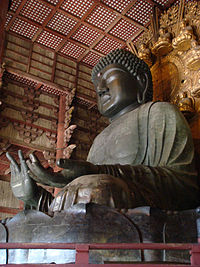 Buddhas (Nyorai-bu):Bodhisattvas (Bosatsu-bu):Vajraparamita (Kongō-Haramitsu) | Vajrasattva (Kongosatta) | Maitreya (Miroku) | Avalokitesvara (Kannon) | Samantabhadra (Fugen) | Manjusri (Monju) | Mahapratisara (Daizuigu) | Ksitigarbha (Jizo) | Akasagarbha (Kokuzo) | Mahasthamaprapta (Seishi)Wisdom Kings (Myōō-bu)Five Wisdom Kings | Acala (Fudo-Myoo) | Rāgarāja (Aizen-Myoo) | Ucchusma (Ususama) | Hayagriva (Bato Kannon) | Mahamayuri (Kujaku-Myoo) | Yamantaka (Daiitoku)Deities (Ten-bu):Shitennō | Marici (Marishi-ten) | Mahakala (Daikokuten) | Saraswati (Benzaiten) | Brahma (Bonten) | Hotei | Jurōjin | Fukurokuju | Vaisravana (Bishamonten) | Ebisu | UgajinIzuna Gongen | Atago Gongen | Konpira DaigongenReligious men (Kōsō・Soshi-bu):Bodhidharma | Prince Shōtoku | Kūkai | Saichō | Dōgen Kigen |Honen | Shinran | Nichiren | Sixteen ArhatsCategories:
Buddhas (Nyorai-bu):Bodhisattvas (Bosatsu-bu):Vajraparamita (Kongō-Haramitsu) | Vajrasattva (Kongosatta) | Maitreya (Miroku) | Avalokitesvara (Kannon) | Samantabhadra (Fugen) | Manjusri (Monju) | Mahapratisara (Daizuigu) | Ksitigarbha (Jizo) | Akasagarbha (Kokuzo) | Mahasthamaprapta (Seishi)Wisdom Kings (Myōō-bu)Five Wisdom Kings | Acala (Fudo-Myoo) | Rāgarāja (Aizen-Myoo) | Ucchusma (Ususama) | Hayagriva (Bato Kannon) | Mahamayuri (Kujaku-Myoo) | Yamantaka (Daiitoku)Deities (Ten-bu):Shitennō | Marici (Marishi-ten) | Mahakala (Daikokuten) | Saraswati (Benzaiten) | Brahma (Bonten) | Hotei | Jurōjin | Fukurokuju | Vaisravana (Bishamonten) | Ebisu | UgajinIzuna Gongen | Atago Gongen | Konpira DaigongenReligious men (Kōsō・Soshi-bu):Bodhidharma | Prince Shōtoku | Kūkai | Saichō | Dōgen Kigen |Honen | Shinran | Nichiren | Sixteen ArhatsCategories:- Bodhisattvas
- Buddhism in Japan
- Buddhism in China
- Chinese gods
Wikimedia Foundation. 2010.

